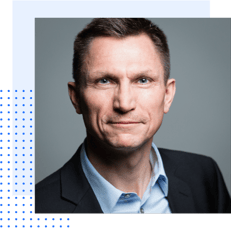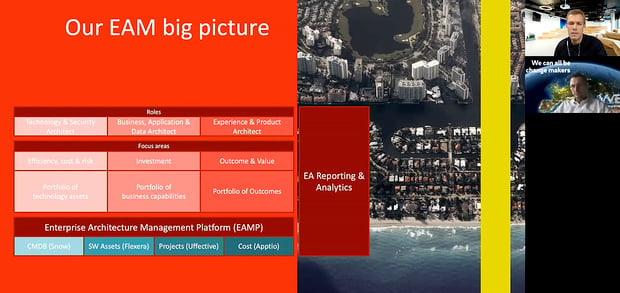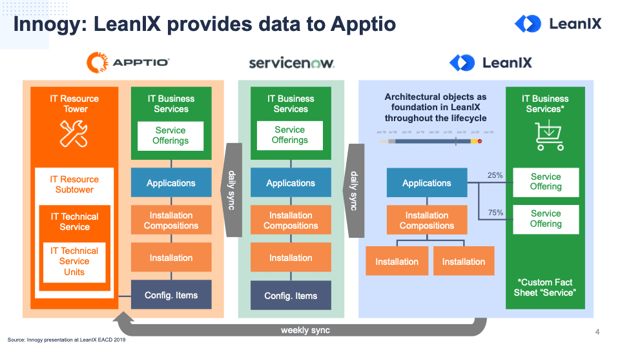
Markus Rink is always looking to the future. As the current head of global technology architecture at E.ON, one of Europe's largest utility companies, his team is in charge of developing an enterprise architecture (EA), vendor landscape, and licensed landscape to support the energy group's external and internal digital business needs.
It's no small feat — especially given E.ON's acquisition of Innogy, the former renewable energy division of RWE, one of its biggest rivals in the German market.
 The goal of the E.ON-Innogy merger has been to develop more customer-oriented solutions and expand business across energy networks. At the same time, Innogy's parent group RWE was to continue focusing on generation and energy supply and trading. But to show how E.ON has so far harmonized its IT infrastructure to make use of these integrated assets, this blog will explore how Rink and his team:
The goal of the E.ON-Innogy merger has been to develop more customer-oriented solutions and expand business across energy networks. At the same time, Innogy's parent group RWE was to continue focusing on generation and energy supply and trading. But to show how E.ON has so far harmonized its IT infrastructure to make use of these integrated assets, this blog will explore how Rink and his team:
- Navigate the complexities of post-merger IT and business landscapes
- Identify and overcome IT challenges in the utilities industry
- Build benchmarks for success with IT management
- Leverage integrations between IT Financial Management (ITFM) and EA
By the numbers
A quick look at the merger of these German energy titans paints an immediate picture of Rink's colossal endeavor. Now servicing a combination of 50+ million customers and hosting a €37bn regulated asset base, E.ON's expanded IT infrastructure allows it to handle a renewable energy network with a 74-gigawatt capacity. The trouble is, since Innogy almost equaled the size of E.ON with hundreds of legal entities of its own, Rink and his team have had to make room for 34,000 incoming employees while exchanging technology assets with RWE. As well, to comply with EU antitrust laws, E.ON was obliged to carve-out portions of its business (and all associated services, applications, data, etc.) for sale to third parties.
Cue the complexity
Rink needed to evaluate all merger activities against a wider backdrop of IT modernization strategies. In particular, in the process of uncovering synergies and rationalization potential across its new 6,000+ application landscape, E.ON had to tailor integrations to support the following:
- A cloud migration
- The adoption of more software-as-a-service (SaaS) solutions
- Delivering new capabilities to the businesses via software
- An enterprise-wide digital transformation
Juggling these requirements led Rink to model ideas to fulfill the likes of improving customer experiences, applying new products and services, and uncovering superior ways of working. Many implementation options were discovered, but the range of possibilities forced Rink to prioritize what to accomplish first for a project of such magnitude yet so little time. As well, it also brought another question into the fold: How to drive progress during the merger with enterprise architecture?
The role of enterprise architecture
In connection to the four initiatives above, it was of utmost importance for E.ON's EA team to generate clear lines of sight throughout its organization to expose risks resulting from new integrations. To ensure EA had this support, Rink put four practices in place:
- A governance body on strategic direction and digital transformation
- To determine what integrations can be completed on short notice (and what might have a long-term impact)
- To align enterprise-wide data with digital transformation and IT modernization plans
- Explicit architecture governance on major architecture decisions
- To improve insights during architectural investments
- To evaluate synergy proposals, modernization projects, and harmonization approaches in light of cloud-first and DevOps practices
- Implicit architecture governance on daily operations
- To stimulate collaboration between IT departments
- To relate individual tasks to the needs of the entire enterprise
- The tracking and management of synergies
- To construct meaningful IT roadmaps
- To implement IT strategies and deliver concrete results
This governance structure was designed to give EA considerable reach throughout E.ON and prevent integration efforts from disrupting long-term strategic agendas. To avoid making decisions that undermined synergy or digital transformation or IT modernization targets, stakeholders were kept in close contact to review data and schedules. Trade-offs were inevitably made, but thanks to EA, architectural reviews became embedded to all transformation tasks to bring transparency to roadblocks and minimize conflicts as best as possible.
Additionally, to weigh all synergy proposals and harmonization approaches, E.ON used architectural governance to focus IT strategy towards ensuring a cloud-first and DevOps practice. This governance now plays an active role in the daily operations of every IT department, and of note, is responsible for coordinating and monitoring the development of roadmaps, the execution of IT strategies, and the delivery of synergies.
A modern IT management framework
E.ON has designed an IT management framework to channel data from business capabilities and technology assets to drive outcome-oriented insights. Underscored via a comprehensive EA management platform, Rink and his team seek to derive more value from IT and business assets by interconnecting CMDBs, software asset repositories, and project portfolio management solutions. When paired with next-generation EA reporting and analytics capabilities, this consolidation of viewpoints supports E.ON's "big picture" IT target of optimizing synergies in terms of efficiency, cost control, and risk — the results of which are leading to better investments in IT for the utilities provider as a whole.
Further, E.ON's IT management framework is structured to help Agile and DevOps delivery models succeed. Like many other enterprises, E.ON's IT landscape is becoming increasingly comprised of cloud-based services and SaaS-based applications, and in order to monitor the financial and technical impact of these investments, Rink and his team must integrate and manage more data than ever before. Putting in place an IT management framework that spans data, business, product, and experience architecture is the only way for E.ON to govern such decentralized landscapes.
Enabling transformation with LeanIX
E.ON rolled out LeanIX across its global operation and has begun using the EA tool as a central repository for all IT assets. The SaaS-based platform makes it possible for Rink and his team to manage portfolios of both business capabilities and technology. When leveraging the integrations to ServiceNow and Flexera and Apptio, their architectural insights contribute to making IT management more outcome-oriented. Having comprehensive views into IT's relationship to a business is essential for guiding post-merger growth, and by performing EA reporting and analytics with LeanIX, E.ON's teams takes advantage of enterprise-wide data to improve business investments while supporting IT efficiency, cost control, and risk management.
In particular, Rink summarizes E.ON's current achievements with LeanIX as the following:
- LeanIX as a tool globally rolled out
- 80% of synergies validated
- EA governance implemented
- Main modernization projects started
- Cost transparency on a service level
Integrating EA with IT Financial Management
LeanIX's integration with Apptio's IT Financial Management tool is key to E.ON's post-merger IT management strategy. As discussed also by Innogy's Christian Schürmann in an interview with LeanIX, the combination of these products is a clear example of the far-reaching benefits of such an integrated toolchain.
By connecting these two tools, data on items such as business capabilities and applications are exchanged between LeanIX and Apptio to group IT costs according to Technology Business Management (TBM) categories — a value management framework for CFOs, CTOs, CIOs, and their various teams. The out-of-the-box, bidirectional information flow means less manual effort when performing ITFM practices, and thanks to LeanIX's intuitive user interface, the data quality of architectural assets can be proficiently maintained to guarantee high-quality financial analytics.
Dashboards in Apptio pull attributes from the LeanIX repository to create different views on application costs. Filters can be applied to see expenditures according to applications running on customer data or supporting specific transformation initiatives — all of which is derived thanks to pools of EA data.
Of note, whatever cost analytics are generated in Apptio can be fed back to EA environments via LeanIX to amass complete overviews of an application. Beyond seeing technology assets according to related user groups and projects, an application's total cost of ownership can be deconstructed to paint a clear picture for business and IT professionals on an entity's value potential.
For use cases varying from application rationalization to technology risk management to cloud migration, the benefits of the LeanIX-Apptio integration include:
- Structuring cloud migration plans by analyzing application data from multiple angles (e.g., technical fit, functional fit, cost, and workload)
- Reducing support costs associated with outdated technologies
- Tethering cost information to application lifecycle data to reduce complexity and improve decision-making
- Seeing how changes to application portfolios affect cost pools
Watch the video below to hear more about E.ON’s post-merger journey to success and the value of an integrated toolset. If you'd like to learn more about the LeanIX-Apptio integration, download our free white paper or read another success story on the subject.
This content is hosted on Youtube.









